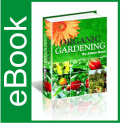How to Plant Garden Vegetable Seeds Indoors
How to Plant Garden Vegetable Seeds Indoors
Article by Stewart Ames
You want to decide beforehand which vegetable seeds you wish to plant. Before you select the seeds do some research as some vegetables cannot be sowed until the last frost has passed. Basically, this means that some garden vegetable seeds, such as onions and carrots for example, cannot be started indoors but must be started in the ground.Gather all of your necessary supplies for the indoor garden. You can use small pots or containers, or to make things a little easier yourself you can purchase seed starter kits. The seed starter kits are an easy way to learn indoor planting. Many of these kits include soil pellets. If you do not have adequate sunlight inside your home for your garden vegetable seeds than also purchase a grow light; these can be found at any home and garden store.With all of your supplies and vegetable seeds ready to plant, first check your growing zone. It is ideal to wait until a month or two before the last frost date of your growing zone to plant your garden vegetable seeds indoors. The reason for this is that the vegetables will have a good start by the time the spring season arrives.When you begin to plant your vegetable seeds, consider the size of the garden that you wish to grow. Once you take that into consideration, plant extra seeds to the already estimated amount. Because when you transport the plants into your garden, the stress caused to the plants during the process might make you lose some of the plants.Now it’s time to add the soil. If you have decided to purchase soil pellets, be sure to read the directions. However, the basic instructions are to allow the pellets to expand by soaking them, placing one seed into each pellet and add water every day. If you’re using the traditional method, place the soil into the pot or container and then place one or two seeds inside of each pot. It’s best to place two seeds just in case if one of the seeds doesn’t make it to the growing phase.Place the garden vegetable seeds under a grow light or a designated sunny location. Be sure that you check the soil every day to see if it needs water. Never let the soil become dry but at the same time never let it get too wet. Healthy soil is firm and moist. Eventually you will notice your garden vegetable seeds starting to sprout. Continue to provide care and maintenance to your garden vegetable seeds inside the house until the risk of frost has passed.You will need to get the plants accustomed to being outside. You do this by taking them outside a week to two weeks before you plan to plant them in the ground. You continue to make daily checks and to provide water as needed. By waiting 1-2 weeks this gives you a chance to quickly bring them back inside if the weather gets close to the freezing mark or frost begins to appear.When it’s time to plant them in the ground, place both the seedling and the soil into the ground. Be mindful that you don’t pull the roots because it will cause them to break. After this point the plants of your garden vegetable seeds are sensitive and can easily dry out and begin to die. So make sure that you water them regularly after transplanting.
About the Author
http://www.mytinygardenshop.com

 October 21, 2011
October 21, 2011 







